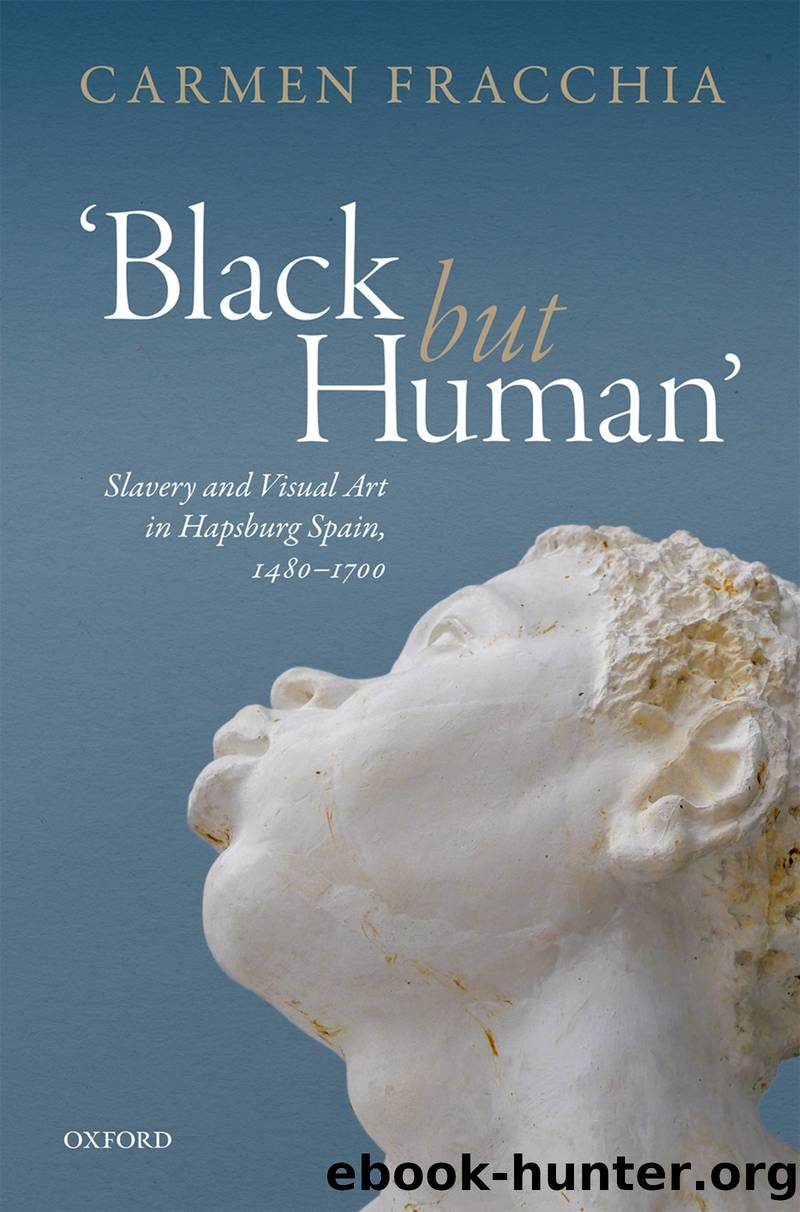'Black but Human' by Carmen Fracchia;

Author:Carmen Fracchia; [Fracchia, Carmen]
Language: eng
Format: epub
ISBN: 9780191080838
Publisher: OUP Premium
Published: 2019-10-03T00:00:00+00:00
5
Commodification
Is There Any Caste Lower Than Blacks and Slaves from Guinea?
(Francisco Nuñez Muley, 1566)1
The Miracle of Saints Cosmas and Damian
The Miracle of the Black Leg, also known as the Miracle of SS. Cosmas and Damian (see Colour Plate 5.1) by the sculptor Isidro de Villoldo,2 in Valladolid (Spain), seat of the Hapsburg court, is perhaps the most remarkable image by Castilian artists in Spain which both allegorizes the violence of the institution of slavery and sets up the iconography of the enslaved Afro-Hispanic subject. This is a uniquely Castilian iconography which articulates this religious legend in the first half of the sixteenth century, as we will see in the second section of this chapter. It is a small panel in polychrome and gilt wood, now in the Museo Nacional de Escultura in Valladolid, that shows the in vivo amputation of the leg of an African man represented in the foreground of the composition.3 He lies on the floor of an elegant room, and the chopping block on which his stump rests adds a contemporary visual motif to this scene, since in early modern Spain this was an essential tool for surgeons (who dealt with wounds, ulcers, tumours, and fractures) to perform amputations on the battlefield to save the lives of wounded soldiers. The amputeeâs left leg has been removed and grafted onto the patient, who holds the stump of his limb with his right hand. The amputee lies in agony by the side of the bed (see Fig 5.1), where a European man is being tended by these two physicians: St Damian on the left is grafting the Africanâs amputated leg on to their patient while St Cosmas, on the right of the composition, is taking the sick manâs pulse and examining his urine in a vessel. Their patient might be sedated, probably with opium, mandragora, or alcohol, unlike the African man.4 This horrific scene takes place in a sumptuous setting, where there is a lavish application of the New World gold that was readily available during the sixteenth century. Painting and gilding highlight the surface of the wood and foregrounds the rich textures of the short tunic worn by the suffering African man, the long, red, Spanish academic gowns and the golden capes of the holy physicians, their shoes, the sheet covering the patientâs body, his pillow cases, and the base of the four-poster bed that occupies the centre of the panel. This technique of the magnificent estofadoâthe âpainted and gilt decoration imitating the textiles or stuff (estofa) of the draperiesââfound in Spanish sculpture had originated in the Netherlands in the late fifteenth century.5
Fig. 5.1. Isidro de Villoldo, Detail: Mutilated African Man. Isidro de Villoldo, The Miracle of the Black Leg, 1547: © Museo Nacional de Escultura, Valladolid (Spain). © Photo: Javier Muñoz y Paz Pastor, CE0362.
Download
This site does not store any files on its server. We only index and link to content provided by other sites. Please contact the content providers to delete copyright contents if any and email us, we'll remove relevant links or contents immediately.
Verus Israel: Study of the Relations Between Christians and Jews in the Roman Empire, AD 135-425 by Marcel Simon(552)
Infocracy by Byung-Chul Han(548)
Caesar Rules: The Emperor in the Changing Roman World (c. 50 BC â AD 565) by Olivier Hekster(533)
Europe, Strategy and Armed Forces by Sven Biscop Jo Coelmont(484)
Give Me Liberty, Seventh Edition by Foner Eric & DuVal Kathleen & McGirr Lisa(451)
Banned in the U.S.A. : A Reference Guide to Book Censorship in Schools and Public Libraries by Herbert N. Foerstel(451)
Reading Colonial Japan by Mason Michele;Lee Helen;(446)
The Roman World 44 BC-AD 180 by Martin Goodman(441)
DS001-THE MAN OF BRONZE by J.R.A(426)
The Dangerous Life and Ideas of Diogenes the Cynic by Jean-Manuel Roubineau(419)
american english file 1 student book 3rd edition by Unknown(419)
The Oxford History of World War II by Richard Overy(415)
Imperial Rome AD 193 - 284 by Ando Clifford(413)
Introducing Christian Ethics by Samuel Wells and Ben Quash with Rebekah Eklund(413)
Basic japanese A grammar and workbook by Unknown(397)
Literary Mathematics by Michael Gavin;(374)
Language Hacking Mandarin by Benny Lewis & Dr. Licheng Gu(354)
How to Reach the 9.0 in IELTS Academic Reading by IELTS Medical(335)
The Oxford History of the Renaissance by Campbell Gordon;(334)
